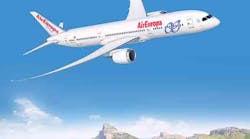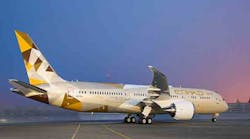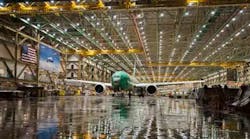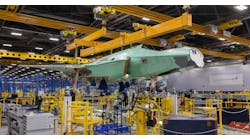Boeing Commercial Airplanes will supply two 747-8 aircraft to the U.S. Air Force, to replace the jets currently designated VC-25 by the USAF and commonly known as Air Force One. No purchase cost or delivery schedule were announced by the Air Force, and no competitive bidding was conducted for the contract.
The current Air Force One stable consists of two 747-200Bs, specially outfitted for presidential service. Those jets were supplied in the early 1990s, when each was supplied for a reported $325 million.
The 747-8 is the third-generation of the 747, with an extended fuselage and wings reconfigured wings from the original design introduced in 1970. It is the largest version of the 747, which is the largest commercial aircraft built in the U.S. It is powered by the GE Aviation GEnx turbofan jet engine, the same units available on Boeing’s new long-range aircraft, the 787.
"The Boeing 747-8 is the only aircraft manufactured in the United States (that) when fully missionized meets the necessary capabilities established to execute the presidential support mission, while reflecting the office of the president of the United States of America consistent with the national public interest" according to Air Force Secretary Deborah James, in a statement.
The particular meaning of that detail apparently is that the 747 is the only four-engine commercial aircraft produced in the U.S., which is important for flight security and safety. Airbus offers a four-engine aircraft, the A380, but it is not built by U.S. workers.
There is speculation that Boeing may be preparing to phase out the 747 program, and late last year it announced plans to scale back production from 1.5 to 1.3 747s per month. The OEM has less than 30 current orders for 747s, and it recorded no new orders for 747s in 2014. Industry analysts have commented that the fuel-saving and emissions requirements of commercial airlines may mean that the future utility of the 747 may be as a freighter aircraft.
“This decision is not a contract award to procure 747-8 aircraft,” explained Col. Amy McCain, who manages the Presidential Aircraft Recapitalization for the U.S.A.F. “We still need to finalize the overall acquisition strategy and conduct risk-reduction activities with Boeing to inform the engineering and manufacturing development contract negotiations that will define the capabilities and cost.”
The Air Force stated intends to acquire enough of “the technical baseline” so that competition for systems and parts may be sustained throughout the aircraft’s planned 30-year lifecycle.
“We are committed to incorporating competition for subsystems of the missionized aircraft as much as practicable, and will participate substantively in any competitions led by the prime contractor,” Secretary James said.










